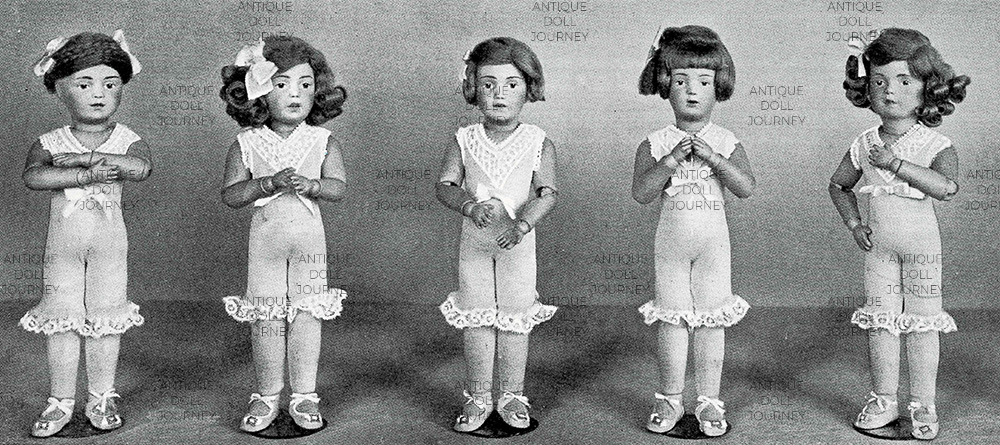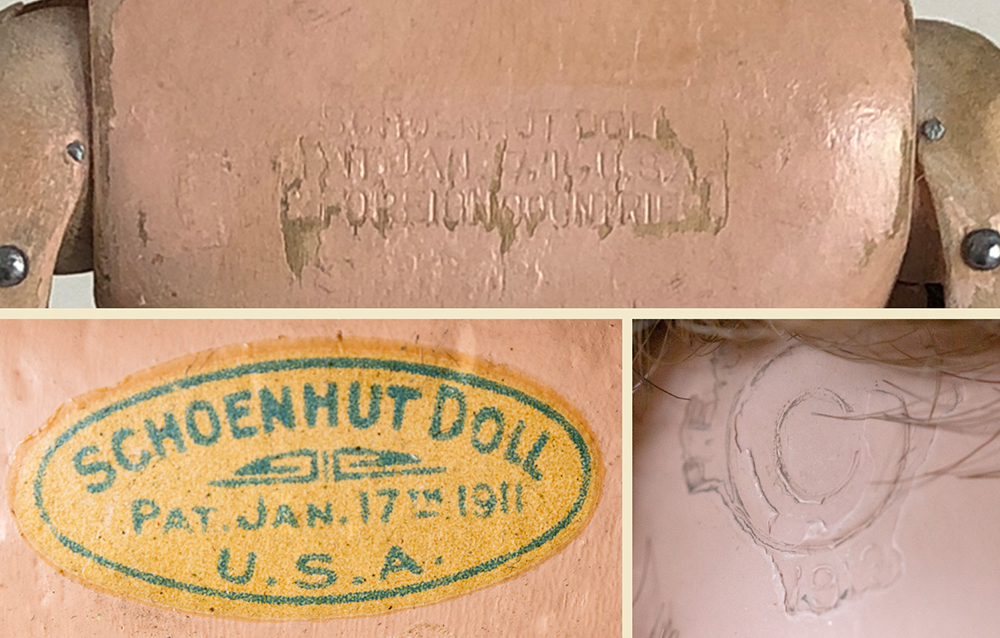Albert Schoenhut (1848-1912), the famous Philadelphian toy manufacturer, came to America from Germany in 1866 at the age of 17 establishing the A. Schoenhut Co. in 1872 which later incorporated in 1897.
His son, Albert F. Schoenhut, claimed that his father had the intention of making instructive as well as amusing toys (Evening Public Ledger, 23 November 1914, page 3). The Schoenhut toy inventions started an era of realism, true-to-life toys with pianos that imitated real pianos because Schoenhut believed that deep down in the heart of every child is the passion for real life, for true stories.
Albert Schoenhut appeared in Moses King’s 1902 “Philadelphia and Notable Philadelphians” described as president of the A. Schoenhut Co. manufacturing Toys and Novelties.

The Schoenhut Store in Philadelphia
A photograph from 1875 shows the storefront of the A. Schoenhut store with a sign over the door that reads “2337 A. Schoenhut Manufacturer of METALLIC TOY PIANOS & METALLOPHONS.”
Trademark
In 1888 A. Schoenhut Co. registered trademark #15,216 with a clown blowing a horn with a body that looks like a xylophone wrapped by the letter S inside a circle.
Schoenhut Patents
On March 25, 1873 Albert Schoenhut of Philadelphia registered patent 137243 for a musical instrument in which the sounds were produced by suspended plates struck by hammers. The object of the invention was to simplify the operating parts and insure the production of clear and distinct sounds. (The 1912 catalog claimed the first instrument had glass plates that were glued on strings. The instrument had no music but a cracked plate had more music!)
The next year he registered patent 157,639 for a child’s sled. The sled acted as a versatile sled that a child could use outside or inside the home as a chair. The patent illustration shows a swan shaped chair with a handle for an adult to push and small wheels on the bottom.
Then in 1875 he registered patent 166,635 for improvement for a reed-organ attachment. The object was to construct a compact and simple piano attachment for organs or melodeons. It was not until 1899 that he filed the patent 658,284 for his famous toy piano which published in 1900.
His patents included a spring air gun (1901), a ladder used by plasterers, paper hangers and others (678,695); a toy boat (1901) intended to sail right side up, and even a musical instrument known as the tubular bell (718,388); and a knock down toy structure illustrated as a tent (842,712) in 1907.
The First Schoenhut Toy Jointed Figure Patent
The jointed figure whose illustration looks like a clown appeared as patent 725,594 in 1903 with another toy figure illustrated as a clown patented (D036917 S) in 1904. His patents for improving upon the jointed toy figures continued with patent 806,008 in 1905 and 858,221 in 1907 illustrated as toy animal joints.
The toys with the weighted rolling bottoms appeared in patent in 1908 (907,092). Followed by the fun dancing toys on mounts in 1910 (patent 980,013).
The Famous Schoenhut Doll Patent
Albert did not patent the famous adored Schoenhut jointed doll figure until 1911 which registered as 982,096, forty-eight years after Joel Ellis invented the first American wood jointed doll. In its details Albert Schoenhut explained: “the object of my invention is to provide a structure of this character with means serving to articulate the several members, such means being of a character as to insure the maximum degree of friction whereby the several limbs and portions of the same may be turned and held in various positions assumed by such turning operations without danger of disarrangement except at the desire of the person using the toy, doll, or jointed figure. In addition. the means which I have provided for articulating the structure are so arranged as to insure movement of the several limbs substantially in accord with the movement of the several limbs of the human body.”
Sons William and Harry Register Patents
Much later in 1920 William Schoenhut patented improvement for the eyes in the wooden doll heads (1358470). Harry Schoenhut’s improved upon this in 1921 with his patent for movable eyelids in the doll head (1387317) and then movable eyes in patent 1390820.
Harry Schoenhut continued the tradition of creating new kinds of toys. He registered a patent for an animal doll (D067677) in 1925 and another in 1928 (D077329).
Albert F. Schoenhut appears again in 1928 for patent 75,527 for a push toy.
1898 Lawsuit
An article appeared in January 1898 regarding a lawsuit filed against Albert Schoenhut by a shop worker. The German American newspaper reporter wrote, “Albert Schönhut, a toy manufacturer in Philadelphia, has been sued by Miss Catharine Hazel for damages for injuries sustained. She states in her statement of claim that in November 1895 she worked for a shop there that purchased naked angels from Mr. Schönhut to decorate Christmas trees. Garments had to be made for these angels, and the plaintiff was commissioned to do this. On November 30, 1895, as she was leaving Mr. Schönhut’s factory in the evening, she fell down the dark stairs and broke her arm and a shoulder blade, and sustained injuries to her back. For this she is now demanding compensation from Mr. Schönhut.”
Humpty Dumpty Circus
Schoenhut invented the Humpty Dumpty Circus, a new thing in the toy business at the time. They confessed that the circus figures helped create business for the toy dealer. The purchase of one clown or elephant insured the regular purchase of additional animals and figures.

Schoenhut All-Wood Perfection Art Doll
Schoenhut’s most important and ambitious invention came out as “the All-Wood Perfection Art Doll” that made of all wood with steel hinges and fully articulated joints first placed on the market in 1911. In 1912 they claimed they used washable oil paints that did not come off in a child’s mouth. Like the Humpty Circus, they designed a doll family with a mama, papa, and children. Then they added doll furniture all aiding the dealer to gain more sales.

Identifying Schoenhut Dolls
Doll collectors identify Schoenhut dolls first by a few defining characteristicis: 1) they are all wood, 2) they have two holes in each foot intended for the foot stand. Collectors and resellers use the old Schoenhut doll catalogs to match the doll face with its model number. In the catalogs dolls had a three digit number that identified their head mold. The numbers appeared beside their heights such as 16/102. The 16 stands for the height of 16 inches. The three digit number 102 stood the doll head with the carved hair and a bow carved in the back. Thus Schoenhut doll collectors or resellers refer to them as Schoenhut 102 or Schoenhut 16/102 or Schoehut 16/308, etc. etc. The mold numbers can help determine the doll’s value as some are more rare than others.
Dressed dolls wore styles that also had a three digit number identifying for ordering.

Advertisements
An ad appeared in the New York Tribune on November 26, 1911 that boasted:
Never were Dolls like These Before – So Beautiful, So Artistic, So Durable, So Sanitary – The Schoenhut All Wood Perfection Art Dolls are so perfectly made and jointed that they will hold any pose you put them in. A metal support free with every doll.
The Schoenhut Dolls are classic figures of children, 16 inches high, made of wood from head to foot, finished in oil colors that can be washed. Fully jointed – not with rubber cord, but with steel-spring hinges with swivel connections. Dressed in exact copies of children’s dresses. The Schoenhut Doll is unbreakable – no more broken heads, loose joints or restringing. Made by skilled Americans in America’s Greatest Toy Factory, their quality far exceeds anything of the kind imported. See this wonderful doll at your dealer’s. The excellence of these beautiful dolls is guaranteed by the fact that they are produced by the makers of the Schoenhut Humpty Dumpty Circus Toys (Toys that Gladden the Hearts of our Dear Little Ones).
Circus with 100,000 new tricks. These are bringing joy and good times to many homes every day. How about the little folks you are interested in? Your children will never tire of playing with these wonderful, unbreakable toys. The animals do tricks; the clowns, in their fancy costumes, are as funny as any Barnum ever had. The figures are made of solid wood, jointed like the French dolls, painted in oil colors. Will stand the roughest kind of treatment. Mothers say it beats any toy they every knew. There is no end to the fun. Sold everywhere, in sets, 50¢ to $25.00. Ask your dealer to show them to you. If you find any difficulty in getting the “Schoenhut” Dolls or “Schoenhut” Humpty Dumpty Circus Toys, write to us today for illustrated literature, and mention your dealer’s name. Don’t send money, write first. The A. Schoehut Company, Mfrs. and Patentees, 2407 Sepviva Street, Philadelphia, Pa. Established 1872. Manufacturers of the World-Renowned Schoenhut Toy Piano.
New York Tribune on November 26, 1911
Ad 1912 Advertisement
In the ads appearing in 1912 Schoenhut added some details while claiming to be the largest toy factory in the world. Better jointed than the French dolls, ads claimed the girl dolls had queen-like beauty and the boys had roguish smiles. Even better, a famous sculptor created the faces of the dolls. The company promised to send illustrated literature upon request.
In 1912 Schoenhut advertised in its catalog the making of toy pianos, metallophones, xylophones, toy guns, toy swords, toy cannons, Rolly Dollys, vocophones, shooting galleries, soldier equipments, toy wooden boats, Humpty Dumpty Circus toys, and last of all dolls.
With a factory that boasted five acres of floor space, the Schoenhut company exported their toys and dolls to all parts of Great Britain, Continental Europe, Australia, South America and other parts of the world. All six of Albert Schoenhut’s sons actively worked in the industry.
Albert Schoenhut died that year, 1912, leaving the business to his six sons.
The Finest American Made Dolls in the Market
A newspaper article appeared in 1914 with pictures of Schoehut dolls. The reporter claimed that the finest American made dolls on the market at that time were Schoenhut dolls. The dolls featured a more companionable facial expression than the typical vacant stare of German made dolls. The article shares pictures of the Schoenhut dolls whispering in conversation and dancing.
In 1915 in the New York Herald announced that the Schoenhut dolls had made there way into the market even in Paris!
Dolls Great for School Use
In 1928 Charlotte G. Garrison wrote in her book, “Permanent play materials for Young Children”, that their durability, range in style and size, and general attractiveness made the dolls especially valuable for school use.
